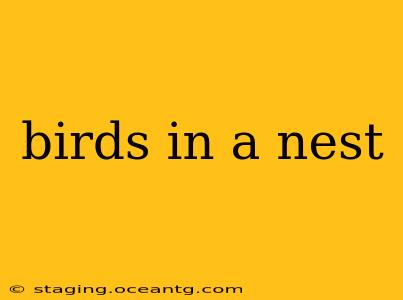Birds' nests are fascinating structures, representing incredible feats of engineering and parental dedication. From the humble cup-shaped nest of a robin to the intricately woven pendulous nest of a weaver bird, the diversity in avian nest construction reflects the varied needs and environments of different species. This comprehensive guide delves into the world of birds in nests, exploring everything from nest building techniques to the importance of nest site selection and the challenges faced by nesting birds.
What types of nests do birds build?
Birds exhibit remarkable ingenuity in nest building, employing a wide array of materials and construction techniques. Nest types vary greatly, ranging from simple scrapes in the ground to elaborate suspended structures. Common nest types include:
-
Cup nests: These are the classic, bowl-shaped nests often associated with robins and other songbirds. They're typically built from twigs, grasses, mud, and other readily available materials.
-
Platform nests: Larger birds like eagles and ospreys build substantial platform nests, often reused year after year, adding new materials each season. These nests can become enormous over time.
-
Cavity nests: Many birds, including woodpeckers, owls, and some ducks, nest in tree hollows or crevices, often modifying existing cavities to suit their needs.
-
Pendant nests: Some species, like weaver birds, construct intricately woven hanging nests, often suspended from branches high above the ground, offering protection from predators.
-
Ground nests: A variety of birds, including many waterfowl and shorebirds, nest directly on the ground, often camouflaging their nests with surrounding vegetation.
Why do birds build nests in certain locations?
Nest site selection is crucial for the survival of a bird's offspring. Birds carefully choose locations that offer:
-
Protection from predators: Nests are often placed in locations that provide camouflage or are difficult for predators to reach, such as high in trees, in dense vegetation, or in concealed crevices.
-
Access to food: Proximity to a reliable food source is vital for feeding young chicks.
-
Suitable materials: The availability of appropriate nesting materials influences nest site choice.
-
Shelter from the elements: Nests are positioned to offer protection from rain, wind, and extreme temperatures.
What materials do birds use to build their nests?
The materials used in nest construction are remarkably diverse and often depend on the availability of resources in the bird's environment. Common materials include:
-
Twigs and branches: These form the structural framework of many nests.
-
Grasses and leaves: These provide insulation and cushioning.
-
Mud and clay: These are used to bind materials together and create a waterproof layer.
-
Spiders' silk and other fibers: These provide strength and flexibility.
-
Animal hair and feathers: These offer warmth and insulation.
-
Human-made materials: Unfortunately, birds sometimes incorporate human-made materials like string, plastic, and even discarded trash into their nests. This can pose a risk to the chicks.
How long does it take a bird to build a nest?
The time it takes to build a nest varies greatly depending on the species and the complexity of the nest. Some birds can construct a simple nest in a few days, while others may spend weeks or even months building more elaborate structures. The process often involves both male and female birds working collaboratively.
What are the challenges faced by nesting birds?
Nesting birds face a multitude of challenges, including:
-
Predation: Predators such as snakes, squirrels, and other birds pose a significant threat to nests and eggs.
-
Habitat loss: The destruction and fragmentation of natural habitats reduce the availability of suitable nesting sites.
-
Climate change: Extreme weather events can damage nests and impact the success of nesting attempts.
-
Human disturbance: Human activities such as deforestation, development, and recreational activities can disrupt nesting birds and lead to nest abandonment.
How can I help birds nesting near my home?
You can help support nesting birds by:
-
Providing suitable habitat: Planting native trees and shrubs provides nesting sites and food sources.
-
Avoiding disturbing nests: Keep pets away from nesting areas and avoid approaching nests closely.
-
Reducing pesticide use: Pesticides can harm birds and their young.
-
Supporting bird conservation organizations: These organizations work to protect bird habitats and raise awareness about the challenges faced by nesting birds.
By understanding the intricacies of bird nesting behavior, we can better appreciate the remarkable adaptations of these creatures and work towards protecting their vital nesting habitats. The delicate balance of nature depends on the success of these avian architects and their incredible nests.
